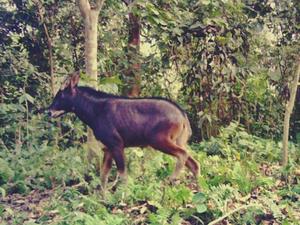
Raimona National Park In Assam Clicks First Photograph Of Endangered Mainland Serow
Forest officials said that the Mainland Serow was spotted in the newly declared Raimona National Park in Kokrajhar district of Assam, adjoining West Bengal and Bhutan.
Assam Forest Department officials accompanied by conservationists of Aaranyak, northeastern region's foremost biodiversity conservation organisation, recently captured the photographic evidence of Mainland Serow in two separate events near the Ganda Bajrum Anti-poaching camp, located in the western range of Raimona National Park, using white flash passive Panthera V6 digital camera traps.
The finding is published as a scientific paper in the Journal of Threatened Taxa.
Divisional Forest Officer of Kachugaon Forest Division Bhanu Sinha said that the discovery of Mainland Serow in Raimona National Park is good news for biodiversity conservation aspects, and we are thrilled by the finding.
"Our goal is to conserve this species and other wildlife extensively in the national park," he said.
The mainland Serow population is widely distributed in the neighbouring Phibsoo Wildlife Sanctuary and the Royal Manas National Park of Bhutan, which may contribute to Raimona National Park's population recovery.
Senior scientist with 'Aaranyak', M. Firoz Ahmed said: "We would like to extend our thanks to the National Park Authority for their collaborative efforts that led to the discovery of this beautiful species.
"There is a wealth of wildlife in Raimona National Park, and the finding of this species is good news for the conservation world. The Mainland Serow (Capricornis sumatraensis thar) is present across various habitats extending from the Himalayas on the Indian subcontinent to southern China, mainland southeastern Asia and Sumatra."
The species' populations are fragmented, isolated, and rapidly declining due to poaching, habitat destruction, and habitat loss.
"The lack of reliable data on this species' abundance and distribution makes it difficult to implement effective conservation actions to ensure long-term survival," said Dipankar Lahkar, a senior conservationist in 'Aaranyak'.
Occasional poaching for bushmeat and habitat alteration due to logging during the ethnopolitical violence are the primary conservation concerns of the Raimona National Park.
With the government now protecting the park, future conservation efforts should consider securing and recovering the species' population and restoration of the degraded habitats, forest officials said.
The Assam government declared the area a national park in June 2021.
After nearly three decades of ethnopolitical violence, the Bodoland Territorial Council (BTR) was established in 2020 and conservation efforts have been fueled since then.

Legal Disclaimer:
MENAFN provides the
information “as is” without warranty of any kind. We do not accept
any responsibility or liability for the accuracy, content, images,
videos, licenses, completeness, legality, or reliability of the information
contained in this article. If you have any complaints or copyright
issues related to this article, kindly contact the provider above.


















Comments
No comment